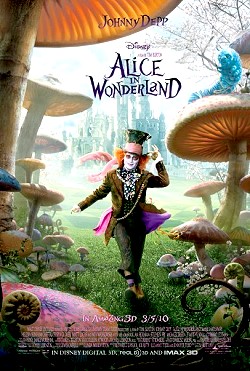
I recently had the pleasure of catching this movie in IMAX 3D, and then later in Dolby 3D. I have not seen this film in a regular theater setting, but then the “buzz” around this film is all about the 3D. One of our SECRETS team has commented on the current film along with his review of the vintage Alice films in our April, 2010 Movie Reviews.
As background, there are several different flavors of 3-D and the IMAX is the oldest (and has a few more trade offs than the others). IMAX, generally shot on 70mm film until very recently, uses very large, linear polarized passive glasses to achieve the desired effect. If you saw Michael Jackson’s Captain EO 3D at Disney World back in 1986, it was the same. The other technologies are RealD (as used in recent Mitsubishi DLPs) and Dolby3D both of which are viewed through circular polarized glasses, a newer technology which generally leads to less artifact, better color gamut reproduction and more subtle three dimensional depth at the expense of that “reach out and grab a bite of your popcorn” feeling you get with IMAX.
Upon further investigation on www.IMAX.com it appears that this film is a little bit different than the regular IMAX movie in that “Alice in Wonderland”, directed by Tim Burton and starring Johnny Depp as the Mad Hatter, was digitally re-mastered for The IMAX Experience(R) with IMAX DMR(R) (Digital Re-Mastering) technology. Which means that this film should have the jump out appeal of the IMAX version while also enjoying a little crisper, dynamic look of digital…we shall see.
The movie begins with a fairly tame scene involving Alice’s betrothal to Hamish, but quickly gets moving as Alice is distracted by a little white rabbit with a pocket watch. As she chases him down a narrow lane with overgrowth zipping past and a canopy of trees above, the audience gets its first taste of truly excellent 3D effect, less so in the Dolby 3D version, though colors were more natural and image was definitely sharper. In fact, on the IMAX version I looked around to see audience members ducking their heads, shrugging their shoulders and the lane grew smaller and smaller, eventually turning into the rabbit-hole. This did not happen on the Dolby version of the movie.
A few observations I made that were consistently reinforced throughout the movie were
1. The IMAX version lends itself largely to movement into or out of the screen. That is, when the camera is first person POV (point-of-view) and chasing another character (as is the case in many of the scenes in this movie) or when something is thrown at or moves very quickly toward the camera, we get a very keen sense of being inside the movie and this is where IMAX really shines. A great example is when the Dormouse throws a teacup at the screen and it seemingly whizzes over your shoulder. The Dolby version, with its better depth, does not allow the cup to actually appear to be “leaving the screen” as the IMAX version does.
2. When there is no inter-scene movement we lose almost all of the 3D effect in IMAX such as when two characters are in dialogue while standing next to each other, such as when Stayne is confronting Hatter for the first time while looking for Alice. This is not the case with Dolby 3D, which has a less-in-your-face dimensional effect. And that effect is not lost very often during the movie. I think that if a film were being shot strictly for IMAX 3D, the directors could maximize the effect by shooting these dialogue scenes in first person, though it might be distracting bouncing back and forth inside each character.
3. The IMAX 3D effect largely breaks down when three or more objects on screen are moving independently of each other. This seems especially the case if moving on the same plane, for example, all are moving left to right and not away from or toward the camera. Again, this is not the case with Dolby 3D. The depth between the characters can be easily distinguished. A great example of this is when Hamish proposes to Alice in front of the large group of people. The front row of people appear to be 10 ft. behind the screen and the back row appears to be several hundred feet behind them with very good perspective between the rows.
In summation, the IMAX version excels at the “coming out of the screen” effect due to the wide/full field of view (~30 ft. tall screens) and the type of polarization effect used to pull off the 3D. This type of 3D is great for children, theme parks and water parks but is technically less correct and more fatiguing to watch, though it may be more intriguing to children!! The Dolby 3D system is much more user friendly. The Dolby version is less fatiguing, sharper, has better color reproduction (though still not great with tinted glasses), much better inter-scene contrast, better black levels, and the 3D effect doesn’t drop out when you tilt or turn your head as the IMAX does. The Dolby 3D is definitely the version I would use on a more frequent basis though it is nice to have the option to see an occasional movie in IMAX 3D for that super-large screen effect.


